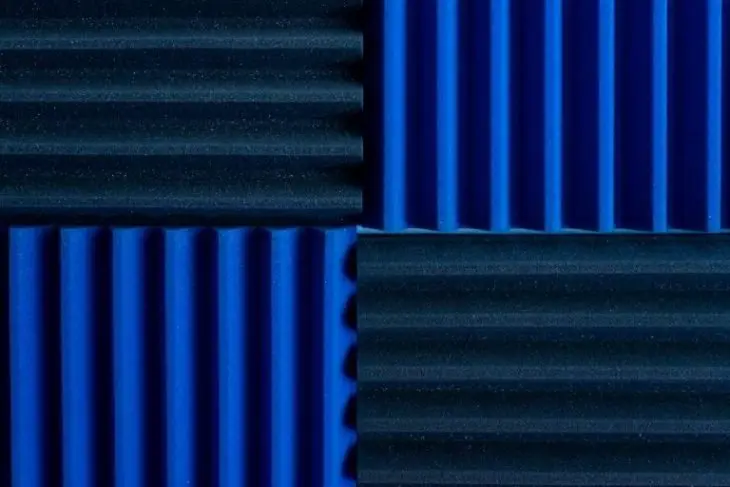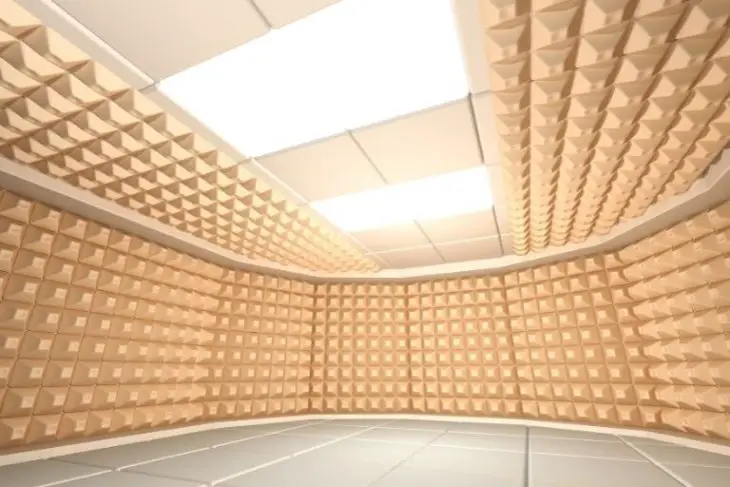Many reasons exist for wanting to find lightweight soundproof material. Perhaps you would like to reduce the noise in your home, or you are building a studio for podcasting or music production and must have a quiet work area. The good news is that you have a range of materials available from professional systems designed for this purpose to some things that you might already have around your home.
Let’s explore some of the materials that you can use to reduce the noise and give your space the acoustic properties that you need.
Table of Contents
Acoustic Louvres
Acoustic louvers are available that air to flow into the area but will reduce unwanted environmental noise. It is similar to a normal shutter that you would find on a building, only the blades and slats are angled or curved so that they disrupt or deflect the sound vibrations. These are used in many office buildings in urban environments.
Acoustic Absorber Panels (External)

Using acoustic absorber panels is another professional option that can create an attractive finish with excellent sound-absorbing qualities. These are often used to keep the sound from reverberating and emitting from a building to the outer environment. They are lightweight and are often made from recycled glass beads. They have an attractive appearance, much like granite or stone.
- Easy to install - If you ever known about our soundproof foam before, you would know how easy to install. Its back with gum, which are lightweight and can be attached to a variety of surfaces. No special tools or materials are needed for installation..The simple but necessary design will decrease your workload.
Prices pulled from the Amazon Product Advertising API on:
Product prices and availability are accurate as of the date/time indicated and are subject to change. Any price and availability information displayed on [relevant Amazon Site(s), as applicable] at the time of purchase will apply to the purchase of this product.
Acoustic Isolation Membrane
You can find many different types of acoustic membranes available. Some are heavy, and some are more lightweight. They also have different capabilities for reducing decibel levels and tend to work best at filtering certain frequencies. These membranes do an excellent job when it comes to reducing sound from transferring from one area of the building to another. You will need to check the weight and compare it to the type of sound that you want to exclude.
- Highest Quality Mass Loaded Vinyl sound barrier, highest sound ratings by weight, heavy weight, odor free, non toxic, safely use anywhere
Prices pulled from the Amazon Product Advertising API on:
Product prices and availability are accurate as of the date/time indicated and are subject to change. Any price and availability information displayed on [relevant Amazon Site(s), as applicable] at the time of purchase will apply to the purchase of this product.
Closed Cell Neoprene
Closed cell neoprene, sometimes called acoustic foam, is a popular choice for recording studios. It does a good job of dampening low-frequency wavelengths, and it can help to reduce echo and reverb in the room. The density of foam makes it a good sound absorber and makes it difficult for sound waves to pass through it.
It does an excellent job of reducing vibrational noise, and it is often used on the feet of washing machines for this purpose. If you have a studio that experiences vibrational noise from mechanical systems, this can be a good choice for lightweight soundproofing material.
- 【Self Adhesive Foam Sheets】These foam sheets are made from Neoprene (CR foam). Resistant to high and low temperatures, can be used from -50℃ to 150℃.
Prices pulled from the Amazon Product Advertising API on:
Product prices and availability are accurate as of the date/time indicated and are subject to change. Any price and availability information displayed on [relevant Amazon Site(s), as applicable] at the time of purchase will apply to the purchase of this product.
Fiberglass & Mineral Wool

Fiberglass and are an excellent choice for soundproofing, and they are accessible to most people. They may not be the best choice for reducing vibrational noise, but they are excellent for reducing airborne noise, such as other people talking in another room. You can find acoustical panels specially designed for sound absorption which are usually a fiberglass core encased in an acoustic fabric.
- Noise Insulation: High density and random fiber orientation trap sound waves and deadens vibration time. Perfect for minimizing noise from offices, bedrooms, meeting rooms or spaces close to busy roads.
Prices pulled from the Amazon Product Advertising API on:
Product prices and availability are accurate as of the date/time indicated and are subject to change. Any price and availability information displayed on [relevant Amazon Site(s), as applicable] at the time of purchase will apply to the purchase of this product.
- Thermal, acoustic and anti-vibration insulation material
Prices pulled from the Amazon Product Advertising API on:
Product prices and availability are accurate as of the date/time indicated and are subject to change. Any price and availability information displayed on [relevant Amazon Site(s), as applicable] at the time of purchase will apply to the purchase of this product.
Fiberglass insulation will also help to reduce noise, and you can find fiberglass ceiling panels that will add to the soundproofing effect in the room, too. They are one of the most lightweight soundproofing materials available and are easy to install.
Plywood
Plywood is lightweight, but it usually needs something else if you are building a professional studio. It does have some sound reduction qualities, but you will probably want to use it as the base for neoprene acoustic panels, or other materials. It is cheap and easy to install, and you can get it in a variety of thicknesses for your needs.
Conclusion
Now you have several options for lightweight soundproofing material. Each of them has different applications and is best for certain types of sound sources or frequencies.
Making your environment acoustically isolated for professional sound work means taking a close look at the types of sounds you want to exclude, the structure of your building components, ease of installation, and how much weight they will add to the walls. Combining several different methods might be the best solution, depending on your specific soundproofing goals.
Recommended Reading
Best Noise Cancelling Headphones For Studying
Looking for a high-quality set of noise-canceling headphones for studying? If you are, read through this guide to find the best products out there.
Best Quiet Dehumidifier
Have you ever moved aside an old box or peered into some dark corner of your house only to be dismayed to find mold growing there?
10 Best Oil Additives to Quiet Noisy Lifter with Reviews
Looking for the best lifter noise additive for your vehicle? If you’re unsure which additives for noisy lifters is best, then read on!
10 Best White Noise Machine for Baby with Reviews
In this article, I have shared information on 10 best white noise machine for baby or babies. These best white noise machine will let your babies sleep well.
Best Quiet Humidifier for Home
Quality humidifiers are essential for healthy home living in dry climates or seasons. If your home environment lacks air with sufficient moisture levels,...
Best Quiet Garage Door Opener (Top 10 Full In-depth Review)
In this article, I will review 10 best quiet garage door openers. I have covered in-depth information on Quietest or Silent Garage Door Opener with their specs.